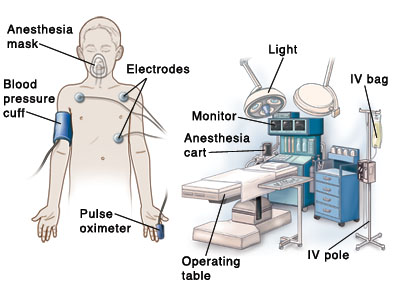The Operating Room
What is the operating room like?
The operating room can be a scary place, with unfamiliar equipment and people dressed in strange outfits. If your child visits the hospital before surgery, a child life specialist can show them some of the equipment. A child life specialist is trained in the growth and developmental needs of children.
One thing your child will need to know is that people in the operating room will be wearing surgical clothes. This is done to help prevent germs from causing an infection.
Surgical clothing may include:
A protective cap covering their hair
Masks covering their mouths and noses
Shades or glasses over their eyes
Gloves on their hands
Long gowns over their clothes
Protective covers on their shoes
The surgeon may also wear special glasses that help them see more clearly.
Children need to be aware that the people in the operating room will be wearing this clothing. They can become frightened if they're not aware that the staff will be wearing strange clothes. If your child is able to visit the hospital before surgery, ask if your child can play with the gloves, mask, and cap so they're not so scary.
Learning about the operating room equipment
The following is a brief list of equipment your child may see in the operating room. However, each operating room varies depending on the type of surgery being done. Also, many children are given medicine to help them sleep before going to surgery, so they may not be awake enough to notice the equipment.

The operating table in the center of the room can be raised, lowered, and tilted in any direction.
The operating room lights are over the table to provide bright light, without shadows, during surgery.
The anesthesia machine is at the head of the operating table. This machine has tubes that connect to the patient to help them breathe. Built-in monitors help control the mixture of gases in the breathing circuit. They also measure the child's heart rate and blood pressure.
The anesthesia cart is next to the anesthesia machine. It contains the medicines, equipment, and other supplies that the anesthesiologist may need.
Sterile instruments to be used during surgery are arranged on a stainless steel table.
Adhesive patches are placed on your child's chest to measure their heart rate and breathing. They connect to the monitor.
The pulse oximeter machine attaches to the patient's finger with an elastic bandage. It measures how much oxygen is in the blood.
There will be a blood pressure measuring machine that automatically inflates the blood pressure cuff on your child's arm.
An electrocautery machine uses high-frequency electrical signals to cauterize or seal off blood vessels. They may also be used to cut through tissue with a minimal amount of bleeding.
If needed, a heart-lung machine or other specialized equipment may be in the room.
If your child is awake and still has questions about the equipment once they go into surgery, the surgical staff can answer them. Ask the child life specialist what words to use to describe the operating room equipment to your child.
Connect with us:
Download our App: